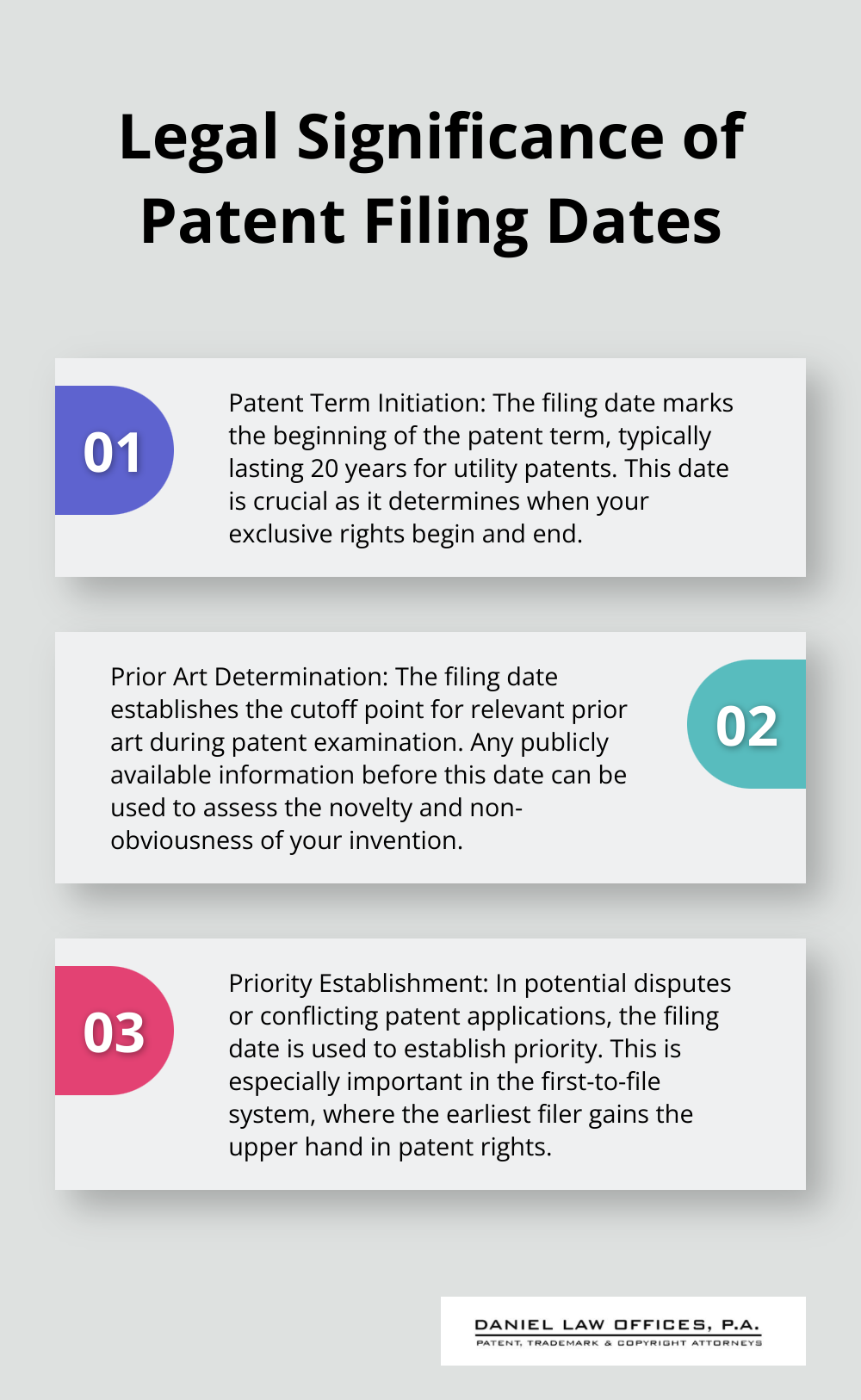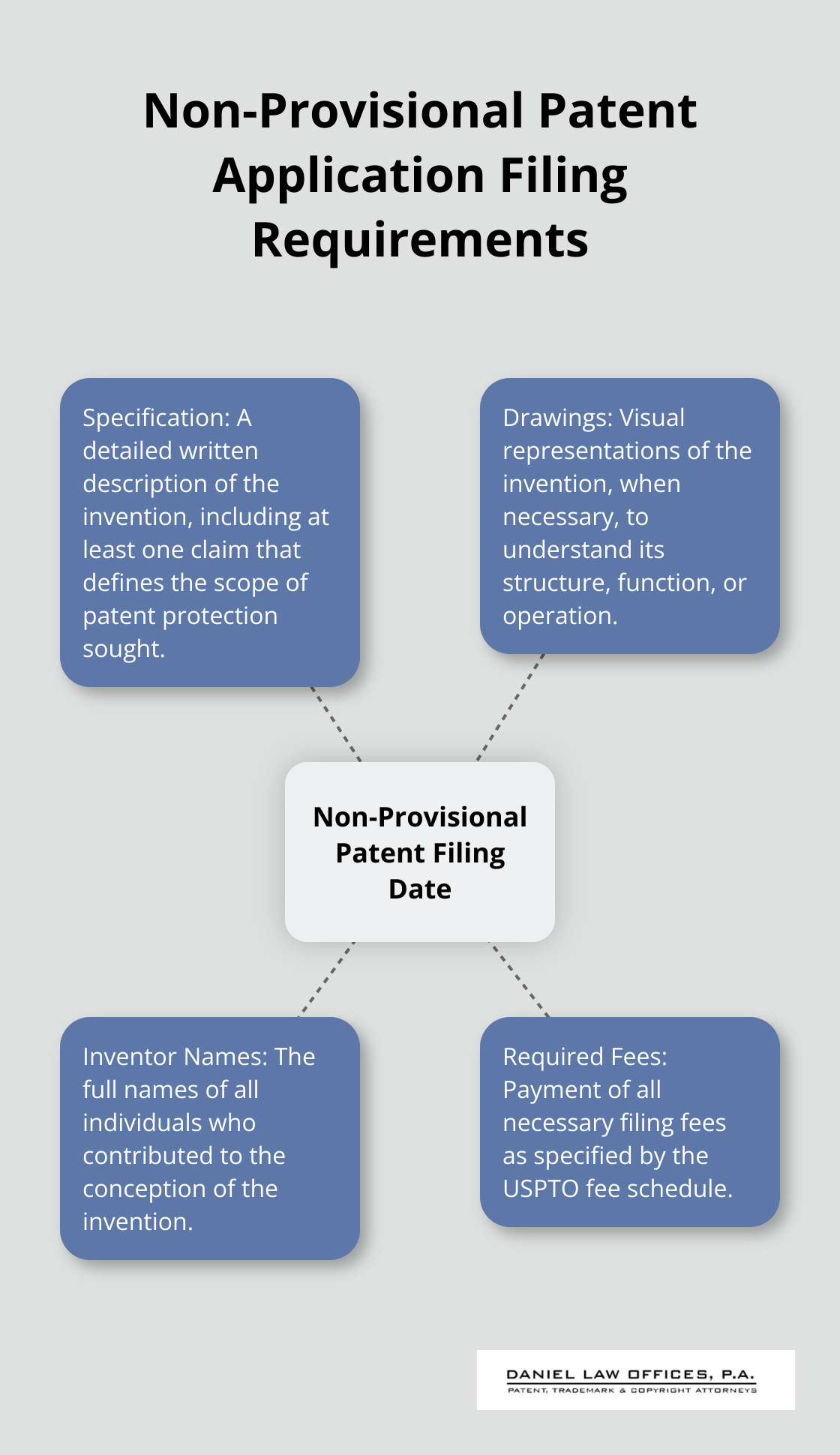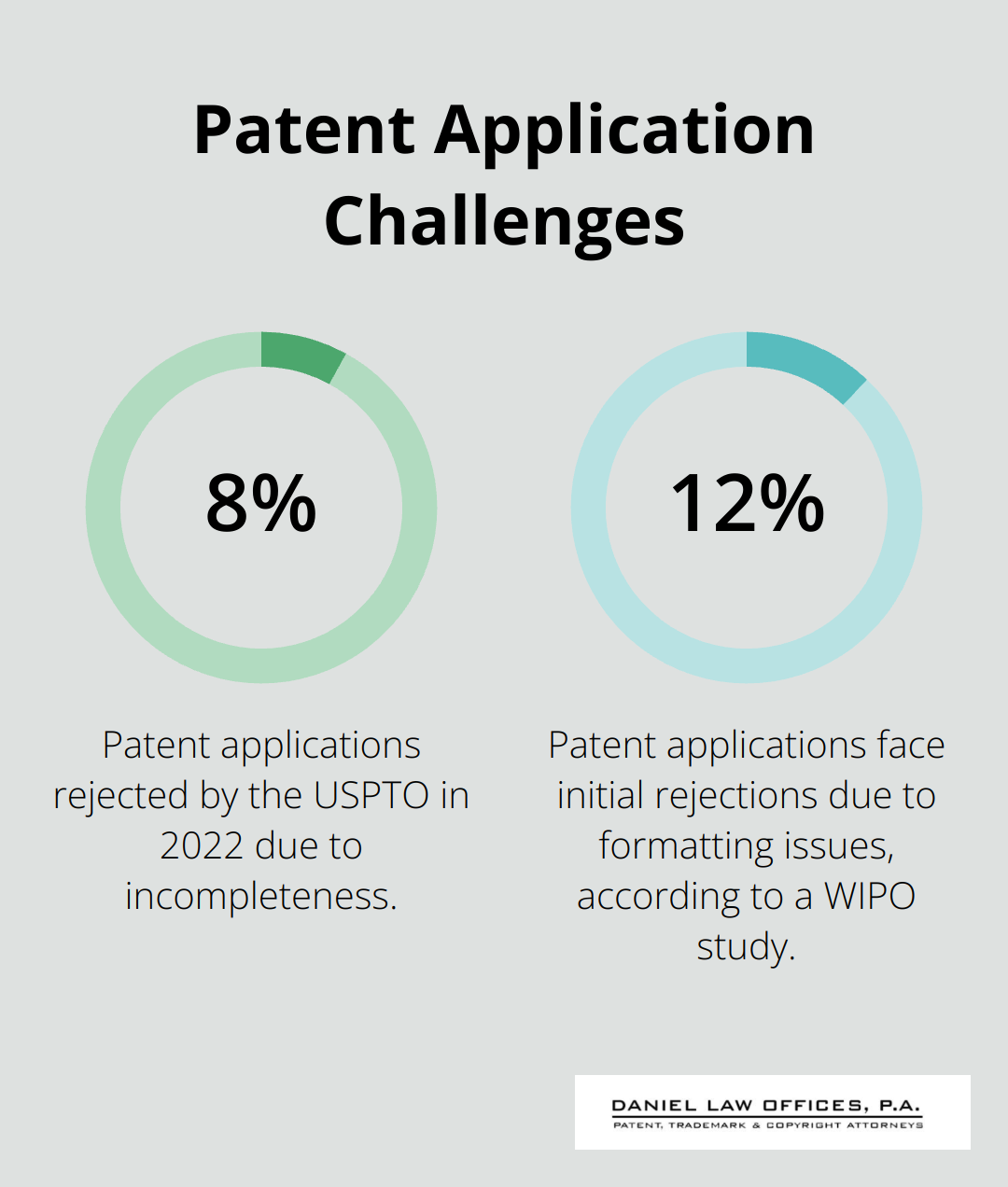How to Determine a Patent Filing Date in Orlando, Florida
At Daniel Law Offices, P.A., we understand the critical role of patent filing dates in protecting your intellectual property.
Determining the correct patent filing date can make or break your invention’s legal protection. This blog post will guide you through the process of establishing your patent filing date in Orlando, Florida.
We’ll explore different types of patent applications and factors that can impact your filing date, providing you with essential knowledge for your patent journey.
What Is a Patent Filing Date?
The Official Start of Patent Protection
A patent filing date marks the official moment when the United States Patent and Trademark Office (USPTO) receives a complete patent application. This date sets the foundation for your invention’s legal protection.
First-to-File: The Race for Priority
The United States operates under a “first-to-file” system. This system awards priority to the first person who files a patent application for an invention (regardless of who invented it first). This creates a competitive environment where inventors and businesses must act quickly to secure their rights.
Legal Significance of Filing Dates
Filing dates carry substantial legal weight. They:
- Initiate the patent term (typically 20 years for utility patents)
- Determine relevant prior art for examination
- Establish priority in potential disputes

Types of Patent Applications and Their Filing Dates
Provisional Patent Applications
These applications offer a quick, less expensive route to establish an early filing date. However, they:
- Last only 12 months
- Must be followed by a non-provisional application to maintain the priority date
Non-Provisional Patent Applications
These are full patent applications that undergo USPTO examination. The filing date is set when the USPTO receives all required components.
PCT International Applications
For inventors seeking global protection, the PCT filing date serves as the effective filing date in all designated countries (a valuable tool for international patent strategies).
Precision: The Key to Patent Protection
Accurate determination and documentation of your patent filing date is essential. Errors can result in:
- Loss of patent rights
- Invalidation of your patent
- Weakened legal position in disputes
This underscores the importance of working with experienced patent attorneys who understand the nuances of patent law and can ensure your application is filed correctly and on time.
As we move forward, let’s examine how to determine filing dates for different types of patent applications, a process that requires attention to detail and a thorough understanding of USPTO requirements.
How Filing Dates Are Determined for Different Patent Applications
Provisional Patent Application Filing Date
The USPTO sets the filing date for a provisional patent application on the day it receives:
- A written description of the invention
- Any necessary drawings
- The names of all inventors
- The required filing fee
The USPTO does not examine provisional applications. These applications act as a 12-month placeholder, preserving your priority date until you file a non-provisional application.
Non-Provisional Patent Application Filing Date
For non-provisional applications, the USPTO establishes the filing date when it receives:
- A specification with a description and at least one claim
- Drawings (when necessary)
- Names of all inventors
- Required fees
The USPTO will notify you if any elements are missing. You will then have a limited time to provide the missing parts without losing your filing date.

PCT International Application Filing Date
The filing date for a Patent Cooperation Treaty (PCT) application is typically set when the receiving office obtains:
- An indication that the application is intended as a PCT application
- Identification of at least one contracting state
- Name of the applicant
- A description of the invention
The PCT filing date becomes the effective filing date in all designated countries (provided you enter the national phase within specified timeframes).
The Role of Completeness and Accuracy
Completeness and accuracy play a vital role in securing your desired filing date. Even minor errors or omissions can push back your filing date, potentially putting your patent rights at risk. This underscores the value of working with experienced patent attorneys who can ensure all requirements are met on the first submission.
The Impact of Amendments and Corrections
Amendments or corrections to your patent application can affect your filing date. The USPTO may assign a new filing date if substantial changes are made to the original disclosure. This highlights the importance of submitting a thorough and well-prepared application from the start.
The determination of filing dates involves complex procedures and requirements (which vary by application type). As we move forward, we’ll explore the factors that can influence your patent filing date and how to navigate potential challenges in the process.
What Impacts Your Patent Filing Date
The Completeness Challenge
The USPTO requires a complete application to establish your filing date. This includes a detailed description of your invention, necessary drawings, and at least one claim for non-provisional applications. Incomplete submissions can delay your filing date and put your patent rights at risk.
In 2022, the USPTO rejected 8% of patent applications due to incompleteness. This statistic highlights the need for thorough preparation when submitting your application.

Fee Payment Precision
The USPTO demands timely payment of all required fees to secure your filing date. The fee schedule is complex and changes periodically. For instance, in 2023, the basic filing fee for a utility patent application is $320 for a large entity (this can vary based on your status and application type).
Late or incorrect fee payments can result in a later filing date or application abandonment. We suggest setting up a USPTO deposit account to streamline fee payments and avoid delays.
Documentation and Formatting Requirements
The USPTO has specific requirements for margins, page numbering, and font size. Non-compliance with these standards can lead to rejection or processing delays for your application.
A World Intellectual Property Organization (WIPO) study found that 12% of patent applications face initial rejections due to formatting issues. This underscores the importance of meticulous attention to detail in application preparation.
Impact of Amendments and Corrections
Amendments or corrections to your application after submission can affect your filing date. The USPTO may assign a new filing date if you make substantial changes to the original disclosure, which could impact your patent rights.
The Value of Professional Assistance
The patent filing process involves complex procedures and requirements. Working with experienced patent attorneys can help you navigate these complexities and secure the earliest possible filing date for your invention. (They can ensure all requirements are met on the first submission, reducing the risk of delays or rejections.)
Final Thoughts
The patent filing date holds immense importance in the protection of intellectual property. This date establishes priority and sets the foundation for your invention’s legal safeguards. Errors or omissions in the application process can lead to delays or rejections, which may jeopardize your invention’s protection.
The complex nature of patent law and the high stakes involved make professional assistance invaluable. Daniel Law Offices, P.A. guides clients through every step of the patent process, from initial searches to application filing (and beyond). Our team of registered patent attorneys understands the nuances of intellectual property law.
Inventors and businesses in Orlando who want to protect their innovations should take action now. We recommend you consult with a patent attorney to discuss your invention and develop a strategy for securing your patent rights. This proactive approach will help safeguard your intellectual property and position your innovation for success in the marketplace.

